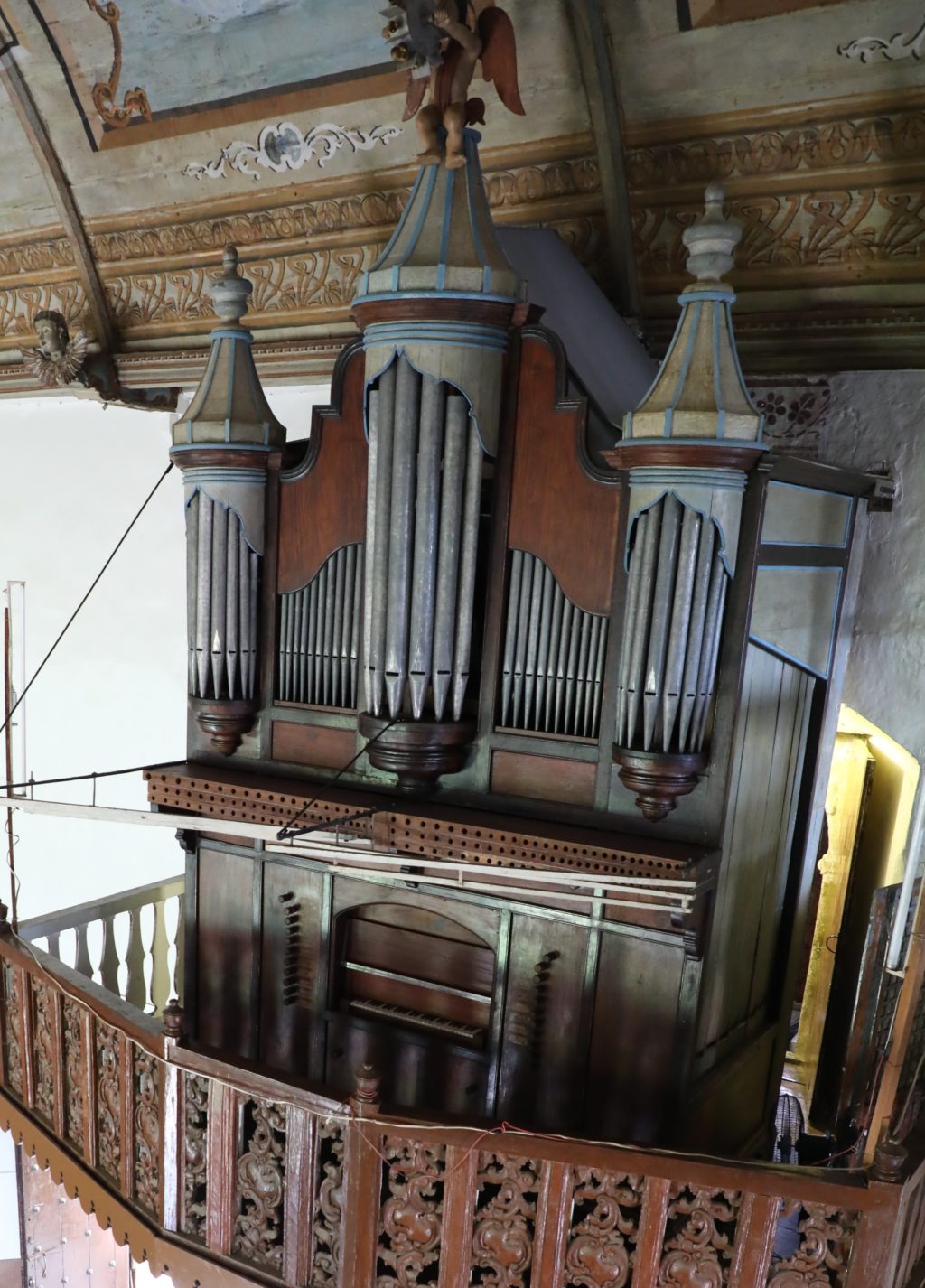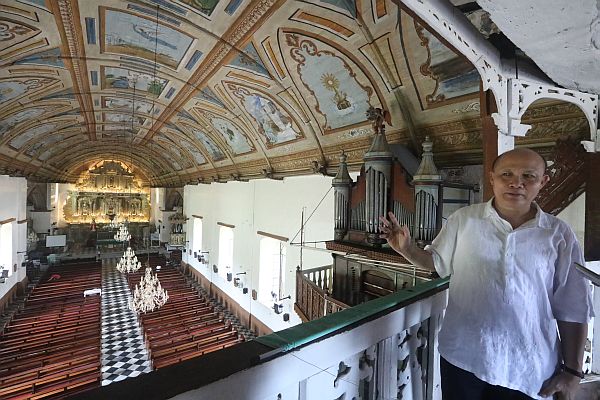The pipe organ of Argao will be silent no more

The centuries-old pipe organ sits on top of the side balcony of the Archdiocesan Shrine of St. Michael the Archangel in Argao town. The musical instrument has been idle for about 40 years. It was restored by the National Historical Commission of the Philippines and will be presented to the people in a concert on Saturday, December 9.
CDN PHOTO/TONEE DESPOJO
‘Instrument of the angels’
For four decades, Charissa Mae Sarchez had an ardent wish she thought would just remain a pipe dream.
“I really wanted to hear the sound of our pipe organ in church. I’m now 42 years old and yet I have not heard even its minutest sound,” said Sarchez, the pianist whose grandmother used to play the custom-made organ at the Archdiocesan Shrine of St. Michael the Archangel in Argao town, south Cebu.
“I did not hope too much because I was told that it was severely damaged, and if ever we have it repaired, it would cost millions of pesos. Perhaps not in my lifetime,” she lamented.
But Sarchez made such as conclusion too quickly.
Just as restoration works were done to repair portions of the town’s historic church that was damaged by the 7.2 magnitude earthquake that rocked Cebu and neighboring Bohol in October 2013, priests assigned to the shrine in 2014 requested the National Historical Commission of the Philippines (NHCP) to also fix its pipe organ, which sat idle on the church’s side balcony for 40 long years.
Msgr. Camilo Alia, moderator of the shrine’s team of pastors, said it was imperative to restore Argao’s pipe organ which is an enduring symbol of Cebu’s culture, history and heritage.
“The pipe organ is very significant, and restoring it was badly needed,” he told Cebu Daily News.
The stringent process of restoring the pipe organ began in 2015 under the supervision of the NHCP, a government agency tasked to promote Philippine history and culture, as well as preserve heritage sites and properties.
The NHCP, in collaboration with the Department of Tourism, spent at least P4 million for the restoration of Argao’s musical masterpiece which was estimated to have been installed in the 1800s by Padre Diego Cera, an Augustinian Recollect priest from Graus, Spain.
The Diego Cera Organ Builders Inc., curator of the world-famous bamboo organ of Las Piñas, was commissioned to execute the restoration.
“There were pipes that needed to be replaced, so new pipes from Las Piñas had to be shipped to Cebu piece by piece. They also had to replace the actual keyboard,” Alia said.

Msgr. Camilo Alia, team moderator of the Archdiocesan Shrine of St. Michael the Archangel in Argao town, explains the significance of the pipe organ, one of the treasures of Argao and Cebu.
CDN PHOTO/TONEE DESPOJO
Awit Halad
By next week, or on December 9, Argaoanons and other people will finally get the chance to hear the newly-refurbished pipe organ of Argao in a concert inside the Hispanic church, ending four decades of anticipation and prayerful waiting.
Aside from launching the musical instrument, the concert dubbed as “Awit-Halad pipe organ concert” is also meant to raise funds for its maintenance.
A ticket costing P500 entitles the person to a seat inside the church. Wide screens will also be mounted outside the church to allow parishioners who have no tickets to witness the concert, which will feature the Colawin Children’s Rondalla, Diego Cera singers and musicians, and local choirs led by the Argao Minstrels Choir.
The 7 p.m. concert will be preceded by a thanksgiving Mass to be presided over by Cebu Archbishop Jose Palma at 3 p.m. at the coral stone church built by the Augustinian missionaries in 1788.
Sarchez, a pianist of the Argao Shrine for 20 years now, said she could not wait to finally play the pipe organ during the concert — a childhood dream that is now within reach.
“I’m super excited. The feeling is so wonderful. I’m so happy. I was told that my lola (grandmother) used to play this pipe organ, and now I will be able to do it too,” she said as tears welled up in her eyes.
Sarchez was taught by her mother to play the piano at the age of nine. She eventually studied at the Colegio de la Inmaculada Concepción in Cebu City where she earned her Bachelor’s degree in music.
At present, Sarchez leads the Argao Minstrels Choir which renders hymns during Sunday Masses at the shrine as well as in liturgical celebrations during Christmas and Lent.
Inspiring sacred music
Fr. Brian Brigoli, chairperson of the Cebu Archdiocesan Commission on Culture and Heritage, said sacred music, especially accompanied by the pipe organ, can penetrate and set the hearts of people.
“Sacred music inspires us. It uplifts our spirits, and is offered for the exhortation of God. The pipe organ, which is considered by many as the ‘instrument of the angels’ is part of our history; an aid in the propagation of the faith,” he said.
Brigoli said the musical instrument in Argao is among the three pipe organs in Cebu that date back to the Spanish colonial period.
The two others are found in the towns of Dalaguete and Boljoon.
Two bigger pipe organs were also installed at the Basilica Minore del Sto. Niño in 1965, and the Cebu Metropolitan Cathedral in 1996.
“The pipe organ in Argao is the oldest. We have no records yet as to when it was constructed. But there is a big possibility that it was installed sometime in the 1800s,” Brigoli explained.
Argao church’s pipe organ has a total of 700 pipes with 22 different timbres that provides a variety of sounds depending on the preference of the person who uses it.
It was described by professional organ makers as having “windchests constructed from a massive solid wood,” and has similarities with the casework of the pipe organ of the San Agustin Church in Intramuros, Manila.
The pipe organ produces sound by driving pressurized air through organ pipes selected through the keyboard which is played by the hands, and a pedalboard played by the feet.
On top of the musical instrument is an image of an angel carrying a rueda or bell wheel. The Argaoanons, by tradition, call the cherub “Petot.”
Alia said the pipe organ was the last structure restored by the NHCP in Argao, next to the town’s church facade, paintings, museum, and retablo or main altar.
Church history
Based on the records of the Archdiocese of Cebu, the present-day Argao church was completed in 1788.
A wooden retablo intricately covered with gilding or gold paint dominates the altar section. Originally, all religious images therein were all wooden polychrome or painted in various colors.
However, in the mid-2000, the images of the archangels Michael, Rafael and Gabriel, and the Immaculate Conception were all gilded in gold by the then parish priest, thus obliterating the original estofado designs and patterns.
Early this year, Alia said they decided to request the NHCP to restore the original paintings of the sacred images upon the requests of the Argaoanons.
It took about five months for NHCP to bring back the original designs of the centuries-old archangels, and the Blessed Virgin Mary.
Alia, who was assigned in Argao in 2014, said the clergy in and the people of Argao are happy to bring back the glory of the church and everything in it.
“A lot of structures here underwent restoration. I’m just happy that we now have back what we longed for. The sacred images are restored to its original design, and the pipe organ is finally usable after 40 years. To God be all thanksgiving,” the soft-spoken monsignor said.
Disclaimer: The comments uploaded on this site do not necessarily represent or reflect the views of management and owner of Cebudailynews. We reserve the right to exclude comments that we deem to be inconsistent with our editorial standards.
